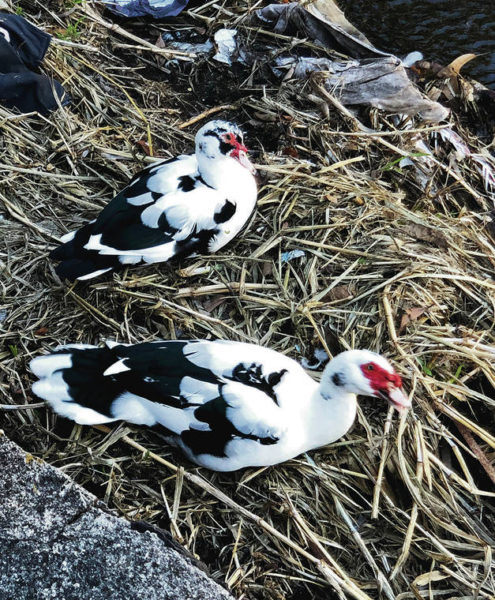Published in the Ocean Watch column, Honolulu Star-Advertiser © Susan Scott
December 14, 2019
Last week’s column about my family’s wildlife sightings at Kaena Point, including the white buttocks of an immature Homo sapiens male, garnered some emails worth sharing.
The funniest came from a woman who informed me that mooning is not passe. “Yes, people still moon others,” she wrote. “I moon some of the 60 or so tourist helicopters that now fly over our house on a daily basis. Sadly, it has not proved to be a deterrent.”
This flash of dissent, named mooning in the 1960s, has been around since the Middle Ages. Since everyone has a pair of cheeks readily available, mooning as protest likely will live forever.
 Two Muscovy ducks rest near Kalakaua Avenue and Phillips Street.
Two Muscovy ducks rest near Kalakaua Avenue and Phillips Street.
©2019 Susan Scott
Speaking of the past, one man shared fond memories of his father taking him camping at Kaena in the 1960s, driving around the point in a VW bug. That ended in the late 1980s, when the state began putting up rock barriers to keep out motorized vehicles.
On the negative side, a reader emailed that decades ago she saw motorcycles in the 59-acre Natural Area Reserve. Another reported his car windows being smashed in the parking lot, also decades ago.
Today researchers, volunteers, police and nature lovers with smartphone cameras are so often coming and going at Kaena Point that the area feels safer to me now than it did years ago.
One reader’s email got me into my car. Jaime wrote, “I’ve noticed what looks to be Snow Geese in the stream on Kalakaua, between Philips St. & King St. for the last 2 months. I know these are not wild ducks because of their size and color. I think somebody needs to investigate & rescue them. They are absolutely beautiful!!!”
Lovely, yes, but the two birds I found during my survey of the canal were not snow geese. They are Muscovy ducks, a goose-size species with distinct red skin and warty wattles on the face. Native to Mexico, Texas and South and Central America, Muscovy ducks have been domesticated for centuries.
The ducks can fly but don’t migrate. People brought Muscovy ducks to Hawaii, where some now frequent our streams and canals.
Snow geese, however, do migrate, making epic journeys from their Arctic breeding grounds to winter foraging sites in the south.
The snow goose population was low in the early 20th century, but today numbers have increased to a point that the geese are destroying parts of the Arctic tundra. Humans caused this overpopulation by converting so much forest and prairie land to farmland. The migrating geese forage in fallow fields where they find ample food.
Because more snow geese exist now than ever before recorded, we shouldn’t be surprised to see more of these beauties wintering in Hawaii.
Last, several readers emailed to commend Craig for confronting the dog people. As a result of his stepping up, we Kaena Point hikers will hopefully have the privilege of watching another albatross chick grow up beside the trail.
Thank you, Craig. May all your future full moons be celestial.